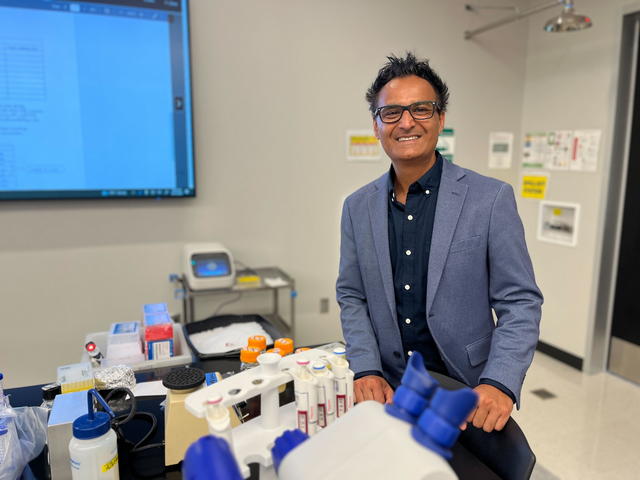Media contact:
 Shahid Mukhtar, Ph.D.,
Shahid Mukhtar, Ph.D.,
Photo credit: Shadid MukhtarThe University of Alabama at Birmingham has recently expanded its undergraduate science research courses thanks to the opening of the new home of the Biology and Physics departments.
South Science Hall and East Science Hall — part of the Science and Engineering Complex — officially opened Aug. 17. The facility offers more than 138,000 gross square feet of classroom, instructional and laboratory space.
UAB’s Office of Service Learning and Undergraduate Research offers one-year fellowship programs to faculty that aim to “develop exemplary curricular approaches to education.” The programs include Faculty Fellows in Service Learning and Faculty Fellows in Undergraduate Research.
Shahid Mukhtar, Ph.D., professor in the College of Arts and Sciences’ Department of Biology, says the Faculty Fellows in Undergraduate Research program perfectly aligned with his curricular interests. Mukhtar says the Faculty Fellows experience played a pivotal role in shaping his Course-Based Undergraduate Research Experience, or CURE, course in genetics. During the fellowship, Mukhtar worked alongside his cohort of fellows to reimagine the design of the course and identify ways to further emphasize active learning. The experience also helped him find opportunities to incorporate real-world issues and challenges into the research conducted by his students.
“This has been one of my most rewarding experiences at UAB, because I am captivated by research,” said Kennedi Brown, a junior majoring in biology who is currently enrolled in CURE 1. “This class allows me an array of great opportunities that most college students could only dream of.”
Through his initial pilot CURE in 2022, 16 students were able to be enrolled and given the opportunity to research plant microbiomes.
Now, with the new Science and Engineering Complex Phase I complete, Mukhtar is looking to utilize the additional lab space to expand the program and reach more students.
“With more dedicated lab spaces, we can accommodate a larger number of students concurrently, allowing for the expansion of existing CURE offerings and the introduction of new ones,” Mukhtar said.
What began as one course impacting 16 students has now expanded to three courses reaching 142 students.
The three courses, BY210, focus on different research topics. In the first, CURE 1, students use duckweed — a high-protein plant that can be found in ponds and other bodies of water — to understand gene function. In the second course, CURE 2, students use a single-cell Chlamydomonas model system to decipher the function of new genes. And, lastly, in CURE 3, students seek to find novel bacteria from Superfund sites.
According to Mukhtar, most of the students in these courses had not worked in a lab before. Given the newness of the experience, several of Mukhtar’s students are immediately recognizing the long-term value of CUREs and are looking forward to doing more research throughout their undergraduate careers and into the future.